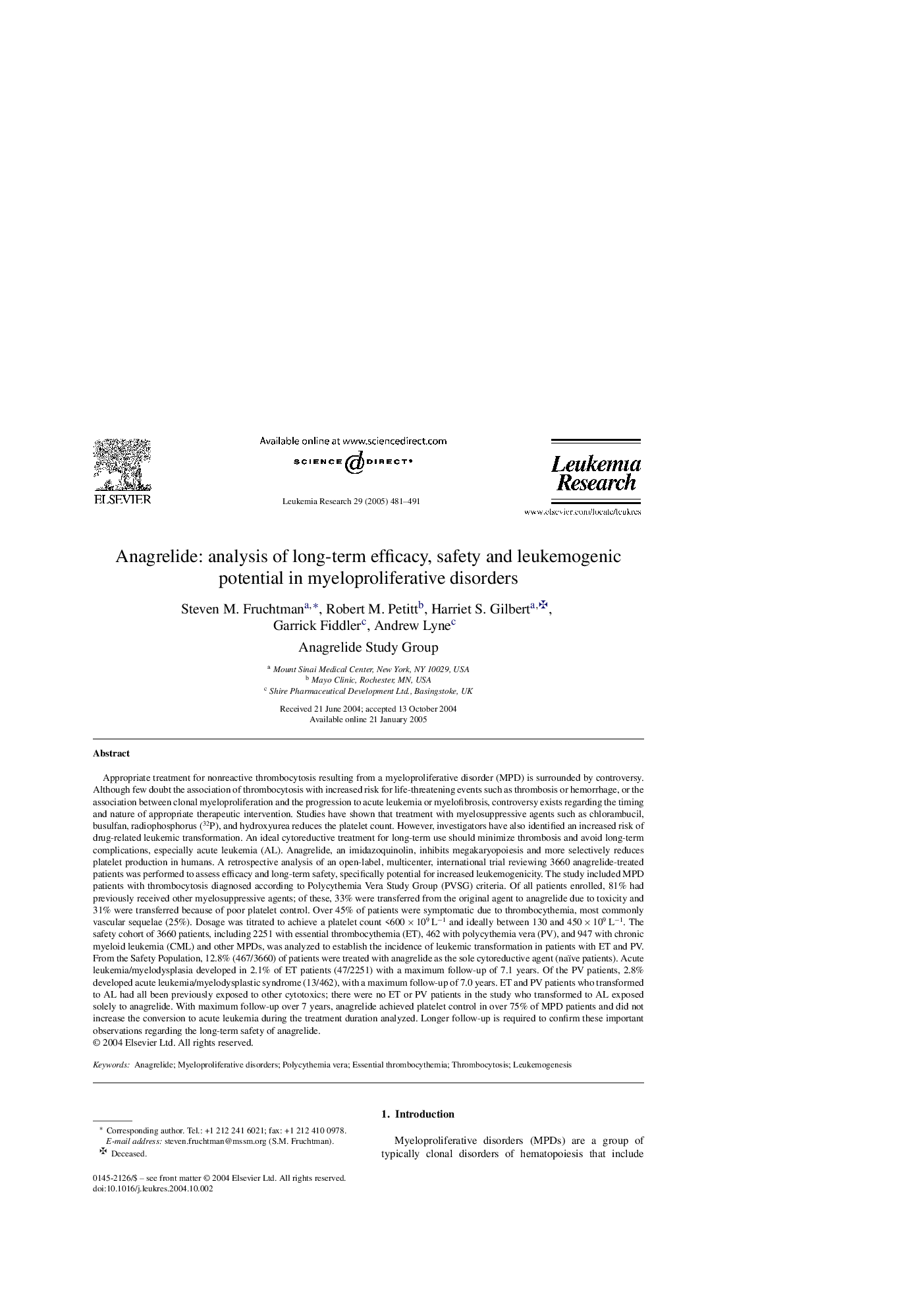| کد مقاله | کد نشریه | سال انتشار | مقاله انگلیسی | نسخه تمام متن |
|---|---|---|---|---|
| 10909525 | 1087910 | 2005 | 11 صفحه PDF | دانلود رایگان |
عنوان انگلیسی مقاله ISI
Anagrelide: analysis of long-term efficacy, safety and leukemogenic potential in myeloproliferative disorders
دانلود مقاله + سفارش ترجمه
دانلود مقاله ISI انگلیسی
رایگان برای ایرانیان
کلمات کلیدی
موضوعات مرتبط
علوم زیستی و بیوفناوری
بیوشیمی، ژنتیک و زیست شناسی مولکولی
تحقیقات سرطان
پیش نمایش صفحه اول مقاله

چکیده انگلیسی
Appropriate treatment for nonreactive thrombocytosis resulting from a myeloproliferative disorder (MPD) is surrounded by controversy. Although few doubt the association of thrombocytosis with increased risk for life-threatening events such as thrombosis or hemorrhage, or the association between clonal myeloproliferation and the progression to acute leukemia or myelofibrosis, controversy exists regarding the timing and nature of appropriate therapeutic intervention. Studies have shown that treatment with myelosuppressive agents such as chlorambucil, busulfan, radiophosphorus (32P), and hydroxyurea reduces the platelet count. However, investigators have also identified an increased risk of drug-related leukemic transformation. An ideal cytoreductive treatment for long-term use should minimize thrombosis and avoid long-term complications, especially acute leukemia (AL). Anagrelide, an imidazoquinolin, inhibits megakaryopoiesis and more selectively reduces platelet production in humans. A retrospective analysis of an open-label, multicenter, international trial reviewing 3660 anagrelide-treated patients was performed to assess efficacy and long-term safety, specifically potential for increased leukemogenicity. The study included MPD patients with thrombocytosis diagnosed according to Polycythemia Vera Study Group (PVSG) criteria. Of all patients enrolled, 81% had previously received other myelosuppressive agents; of these, 33% were transferred from the original agent to anagrelide due to toxicity and 31% were transferred because of poor platelet control. Over 45% of patients were symptomatic due to thrombocythemia, most commonly vascular sequelae (25%). Dosage was titrated to achieve a platelet count <600Â ÃÂ 109Â Lâ1 and ideally between 130 and 450Â ÃÂ 109Â Lâ1. The safety cohort of 3660 patients, including 2251 with essential thrombocythemia (ET), 462 with polycythemia vera (PV), and 947 with chronic myeloid leukemia (CML) and other MPDs, was analyzed to establish the incidence of leukemic transformation in patients with ET and PV. From the Safety Population, 12.8% (467/3660) of patients were treated with anagrelide as the sole cytoreductive agent (naïve patients). Acute leukemia/myelodysplasia developed in 2.1% of ET patients (47/2251) with a maximum follow-up of 7.1 years. Of the PV patients, 2.8% developed acute leukemia/myelodysplastic syndrome (13/462), with a maximum follow-up of 7.0 years. ET and PV patients who transformed to AL had all been previously exposed to other cytotoxics; there were no ET or PV patients in the study who transformed to AL exposed solely to anagrelide. With maximum follow-up over 7 years, anagrelide achieved platelet control in over 75% of MPD patients and did not increase the conversion to acute leukemia during the treatment duration analyzed. Longer follow-up is required to confirm these important observations regarding the long-term safety of anagrelide.
ناشر
Database: Elsevier - ScienceDirect (ساینس دایرکت)
Journal: Leukemia Research - Volume 29, Issue 5, May 2005, Pages 481-491
Journal: Leukemia Research - Volume 29, Issue 5, May 2005, Pages 481-491
نویسندگان
Steven M. Fruchtman, Robert M. Petitt, Harriet S. Gilbert, Garrick Fiddler, Andrew Lyne, Anagrelide Study Group Anagrelide Study Group,